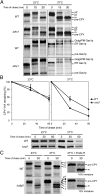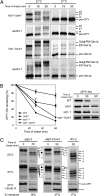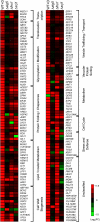The unfolded protein response supports cellular robustness as a broad-spectrum compensatory pathway
- PMID: 22143797
- PMCID: PMC3251055
- DOI: 10.1073/pnas.1117184109
The unfolded protein response supports cellular robustness as a broad-spectrum compensatory pathway
Abstract
Stress pathways monitor intracellular systems and deploy a range of regulatory mechanisms in response to stress. One of the best-characterized pathways, the unfolded protein response (UPR), is responsible for maintaining endoplasmic reticulum (ER) homeostasis. The highly conserved Ire1 branch regulates hundreds of gene targets by activating a UPR-specific transcription factor. To understand how the UPR manages ER stress, a unique genetic approach was applied to reveal how the system corrects disequilibria. The data show that the UPR can address a wide range of dysfunctions that are otherwise lethal if not for its intervention. Transcriptional profiling of stress-alleviated cells shows that the program can be modulated, not just in signal amplitude, but also through differential target gene expression depending on the stress. The breadth of the functions mitigated by the UPR further supports its role as a major mechanism maintaining systems robustness.
Conflict of interest statement
The authors declare no conflict of interest.
Figures





Similar articles
-
Lipid bilayer stress and proteotoxic stress-induced unfolded protein response deploy divergent transcriptional and non-transcriptional programmes.Biochim Biophys Acta Mol Cell Biol Lipids. 2020 Jan;1865(1):158449. doi: 10.1016/j.bbalip.2019.04.009. Epub 2019 Apr 24. Biochim Biophys Acta Mol Cell Biol Lipids. 2020. PMID: 31028913 Review.
-
Functional Coupling between the Unfolded Protein Response and Endoplasmic Reticulum/Golgi Ca2+-ATPases Promotes Stress Tolerance, Cell Wall Biosynthesis, and Virulence of Aspergillus fumigatus.mBio. 2020 Jun 2;11(3):e01060-20. doi: 10.1128/mBio.01060-20. mBio. 2020. PMID: 32487759 Free PMC article.
-
Gcn4p and novel upstream activating sequences regulate targets of the unfolded protein response.PLoS Biol. 2004 Aug;2(8):E246. doi: 10.1371/journal.pbio.0020246. Epub 2004 Aug 17. PLoS Biol. 2004. PMID: 15314660 Free PMC article.
-
The unfolded protein response (UPR) pathway in Cryptococcus.Virulence. 2014 Feb 15;5(2):341-50. doi: 10.4161/viru.26774. Epub 2013 Oct 18. Virulence. 2014. PMID: 24504058 Free PMC article. Review.
-
The broad spectrum of signaling pathways regulated by unfolded protein response in neuronal homeostasis.Neurochem Int. 2018 Oct;119:26-34. doi: 10.1016/j.neuint.2017.06.012. Epub 2017 Jun 28. Neurochem Int. 2018. PMID: 28668471 Review.
Cited by
-
Impairment of RPN4, a transcription factor, induces ER stress and lipid abnormality in Saccharomyces cerevisiae.Mol Cell Biochem. 2023 Oct;478(10):2127-2139. doi: 10.1007/s11010-022-04623-w. Epub 2023 Jan 27. Mol Cell Biochem. 2023. PMID: 36703093
-
Human PERK rescues unfolded protein response-deficient yeast cells.MicroPubl Biol. 2022 Jun 28;2022:10.17912/micropub.biology.000592. doi: 10.17912/micropub.biology.000592. eCollection 2022. MicroPubl Biol. 2022. PMID: 35845817 Free PMC article.
-
Trace elements and metal nanoparticles: mechanistic approaches to mitigating chemotherapy-induced toxicity-a review of literature evidence.Biometals. 2024 Dec;37(6):1325-1378. doi: 10.1007/s10534-024-00637-7. Epub 2024 Sep 30. Biometals. 2024. PMID: 39347848 Review.
-
Histone deacetylase inhibition expands cellular proteostasis repertoires to enhance neuronal stress resilience.bioRxiv [Preprint]. 2024 Aug 22:2024.08.21.608176. doi: 10.1101/2024.08.21.608176. bioRxiv. 2024. PMID: 39229034 Free PMC article. Preprint.
-
Quantitative Structural Proteomics Unveils the Conformational Changes of Proteins under the Endoplasmic Reticulum Stress.Anal Chem. 2022 Sep 27;94(38):13250-13260. doi: 10.1021/acs.analchem.2c03076. Epub 2022 Sep 15. Anal Chem. 2022. PMID: 36108266 Free PMC article.
References
-
- Barkai N, Shilo BZ. Variability and robustness in biomolecular systems. Mol Cell. 2007;28:755–760. - PubMed
-
- Kitano H. Biological robustness. Nat Rev Genet. 2004;5:826–837. - PubMed
-
- Ron D, Walter P. Signal integration in the endoplasmic reticulum unfolded protein response. Nat Rev Mol Cell Biol. 2007;8:519–529. - PubMed
-
- Cox JS, Shamu CE, Walter P. Transcriptional induction of genes encoding endoplasmic reticulum resident proteins requires a transmembrane protein kinase. Cell. 1993;73:1197–1206. - PubMed
-
- Mori K, Ma W, Gething MJ, Sambrook J. A transmembrane protein with a cdc2+/CDC28-related kinase activity is required for signaling from the ER to the nucleus. Cell. 1993;74:743–756. - PubMed
Publication types
MeSH terms
Substances
Associated data
- Actions
LinkOut - more resources
Full Text Sources
Molecular Biology Databases

